Yuyang Zhang
Indra Nooyi was told by her mother to “leave that damned crown in the garage” and tend to her household responsibilities even though she was the director of one of the most important companies in the world (Friedersdorf, 2014).
— Professional women:Where to go?
A survey by Mercer found that in 2020, only 23% of women were in executive positions, while 47% worked as support staff (Catalyst, 2020). As support staff, women are exploited as there are no defined working hours or employee benefits, which can lead to job satisfaction. Aside from this, irrespective of their job profile, women end up going through some shared workplace experiences, such as patronizing behavior of men, male-oriented corporate culture of the suppressing of women’s opinions and lack of safety standards, making women more vulnerable to harassment (WHO 2011).

Source: https://unsplash.com
The 2020 pandemic has made it worse by including homeschooling and care for the elderly in the list of household chores. Mothers were more than three times more likely than fathers to do most of the housework and care during the pandemic (Huang, 2020). The data collected from interviewing 800 Italian households during April-July 2020 also revealed that the changing patterns of lifestyle did not influence men as much. Although both husbands and wives were doing work from home, the former mostly performed their professional responsibility. On the other hand, the women had to do the office work as well as the domestic work. As a result of this, women were left overburdened.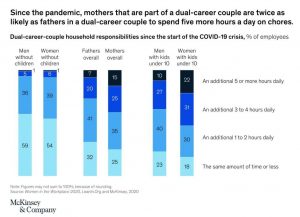
Source: Women in the workplace 2020, LeanIn. Org and McKinsey, 2020
— Work-Life balance: Double pressure
Professional women are under tremendous pressure to develop a career as powerful as men, whilst also trying to maintain an active participation in their personal lives. A study on Work-Life Balance in Working Women (Delina and Raya, 2013) pointed out that it is difficult for married working women to balance work and life. Compared with the 30-40 year-old age group, married professional women under the age of 30 have more problems with work-life imbalance, while married professional women over 40 have a relatively better work-life balance. In terms of spouse’s occupation, respondents with the most serious work-life balance were those whose spouse’s occupation was in business, followed by spouse’s occupational marketing.

Source: https://unsplash.com
In addition, balancing family and work becomes a huge challenge for single mothers, as most of them have no support at home. According to a 2018 study by the China Women’s Development Foundation of nearly 2 million single families in China, as many as 80% of single mothers cannot obtain enough payment from their ex-husbands for the upkeep of their children,and nearly 90% of single mothers act as the major role in raising a child after divorce. In September 2019, 76.1% single moms were employed, which declined to 67.4% employed single moms with children younger than 18 years of age – within the six months since the onset of the pandemic (Pew Research Center, 2020). The 9-point drop is a largest employment gap among all parent groups, single or partnered.
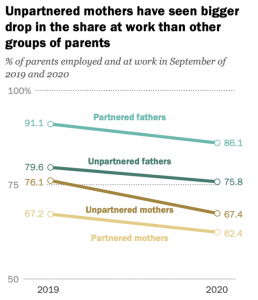
Source: Unpartnered mothers have seen bigger drop in the share at work than other groups of parents.
Whether it is family division of labor or professional competition, the difficulties and challenges faced by women are once again presented in the face of this epidemic, and they bear greater pressure than ever before. Although it has been advocated that all women enjoy the same equality as men’s. However, there are in fact many difficulties to be overcame in order to realize this claim. And women can achieve their real equality only if the deep-rooted opinion of gender responsibility has been transformed, where men would be more willing to invest their energy into the family and the society offer more comprehensive system to protect their rights.
— What can we do?
With changing times, especially in the post-coronavirus era, considering the amount of energy women spend switching between office work and home, businesses and organizations need to adopt policy measures to enable men and women to balance work, family and life. In addition, organizations should also provide companies with childcare services, such as setting up childcare centers near the workplace, in an attempt to help them get some respite from their stressful lives (Sandberg and Thomas, 2020).
Perhaps the road to breaking the working woman’s predicament will require more protracted struggles and efforts. However, in the pursuit of gender equality, as individuals, families and societies, we hope that the crown of women deserves to be seen by more people.
Further reading:
Delina, G. and Raya, R. P. (2013). A study on work-life balance in working women. International Journal of Commerce, Business and Management, 2(5), pp.274-282.


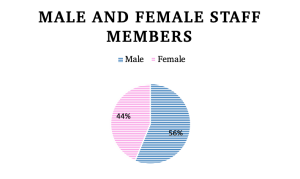
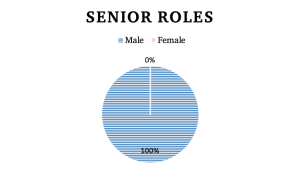 Out of the telesales staff, three are males, with the office manager being male. Out of the six area sales representatives, all are male. Therefore, we are presented with figure 1. Given these observations, you would think that my office is relatively symmetrical in terms of sex distribution. This is not the case, well not in terms of the roles that are performed by each staff member anyway. For example, all seven superior roles are those that the office manager and area sales representatives occupy (figure 2).
Out of the telesales staff, three are males, with the office manager being male. Out of the six area sales representatives, all are male. Therefore, we are presented with figure 1. Given these observations, you would think that my office is relatively symmetrical in terms of sex distribution. This is not the case, well not in terms of the roles that are performed by each staff member anyway. For example, all seven superior roles are those that the office manager and area sales representatives occupy (figure 2).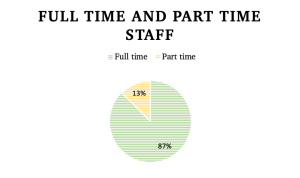 In figure 3, it is shown that all staff members, excluding two, work full-time.
In figure 3, it is shown that all staff members, excluding two, work full-time.